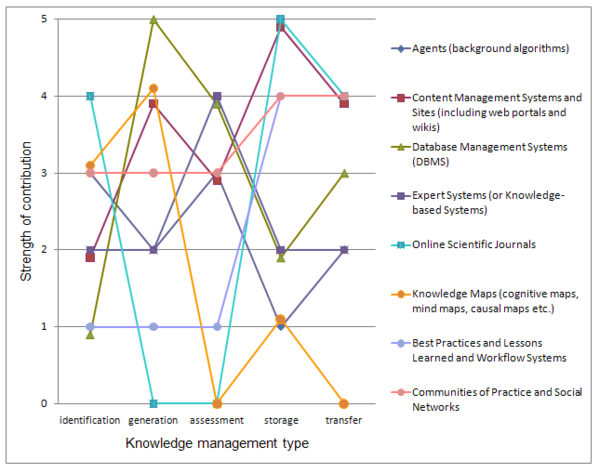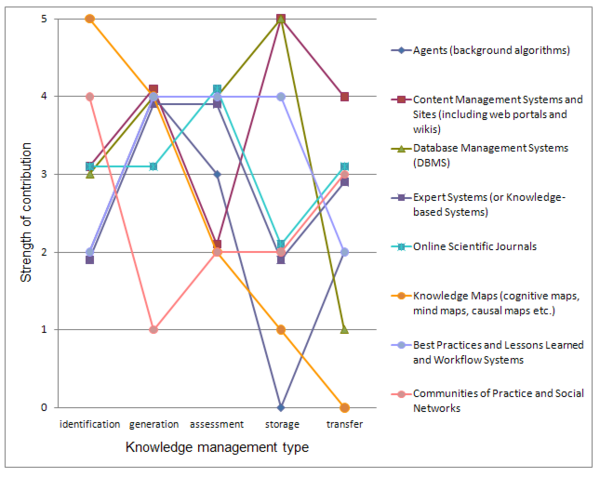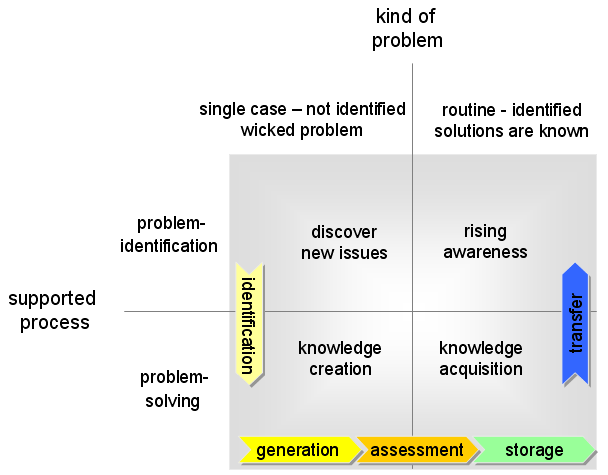Classification of Knowledge Management tools
Contents
- 1 Characteristics of KM approaches in supporting decision making
- 2 Criteria to classify KM tools
- 2.1 Criteria according to the type of the decision problem
- 2.2 Criteria according to stakeholders / users /organisations
- 2.3 Criteria for development issues - technical aspects
- 2.4 Classification of KM tools according to problem solving
- 2.5 Classification of KM tools according to their contribution to knowledge management processes
Characteristics of KM approaches in supporting decision making
KM approaches for Problem identification
- Allow a documentation in order to transfer knowledge to other problem areas or to the next generation
- encourage decision makers to discover new problems and opportunities by exposing themselves to new information, situations, issues, and ideas
- help decision makers in recognizing upcoming problems for which solutions have been developed previously
KM approaches for Problem structuring / modelling
- allow to actively create new knowledge when faced with a new problem and to develop novel solutions
- allow to identify expert knowledge, facts and experiences in relation to decision problem
- allow to codify available knowledge for machine / computer
- allow to reduce complexity
- support the engagement/involvement of experts
- allow to combine various forms of information (qualitative / quantitative)
KM approaches for Problem solving / decision making
- allow to capture and retain knowledge, making it available to decision makers who are seeking solutions from previously solved problems
- facilitate decisions that are reproducable
- facilitate a rationale decision making process
- improve decision making ability
- increase productivity of decision maker (within cognitive, time and economic limits - effective and efficient decisions)
- support the decision-making phases in identifing or analyzing alternatives and/or in giving advice about which alternative to choose
Criteria to classify KM tools
Criteria according to the type of the decision problem
- Decision situation (unilateral, collegial, participatory)
- Level of planning (operational, tactical, strategic planning)
- Challenges / key problems in forestry domain?
- Which goods and services are supported?
Criteria according to stakeholders / users /organisations
- allow participation (active / passive)
- Technical skills of users required
- Level of acceptance of users in terms of usability, reliability, easyness,…
- Kind of introduction of the tool to users
- Role of stakeholder within the process (expert, decision maker, public)
- Who owns the knowledge in organizations? How to make use of the knowledge available? Who coordinates knowledge?
- Type of organization (public bodies, forest enterprises,…)
- To whom give access to information / knowledge (skill, commercial , privacy)
- Data mining of private enterprises (CRM?) of relevance
Criteria for development issues - technical aspects
- Allows to generate interfaces between tools/techniques
- Allows a definition of interfaces between methods and models
- Rules for selecting information (in hierarchical decision making processes, robustness, reliability, …)
- allows to be adapted to new challenges, problems are they flexible enough?
Classification of KM tools according to problem solving
Gray's classification [1] recognizes different types of managing knowledge with regards action motivations in two different types of problems. The motivation can either be problem identification or problem solving, and the problem can be either unique/new or previously solved. Combining these in 2*2 matrix shows us four types of KM: (1) Discovering new issues, (2) Creating knowledge, (3) Acquiring knowledge, and (4) Raising awareness. Shifting between these ascendingly can be seen as (a) identifying, (b) preserving/storing, and (c) distributing/transferring knowledge (see Fig. 1 below).
Fig. 1. Knowledge management types within decision problems after Gray (2003).
Classification of KM tools according to their contribution to knowledge management processes
Based on literature research, web site examples and personal experiences, about twenty KM tools and methods were identified and classified to eight groups. The KM tool groups were evaluated according to their contribution to knowledge management processes within developing DSS on one hand (Fig. 2) and within applying DSS on the other hand (Fig. 3). The figures below show ‘performance profiles’ of the tool groups in the processes of identifying, generating, assessing, storring and transferring knowledge that can be integrated in DSS.
 Fig. 2. Contribution of different KM tools to knowledge management processes in the context of developing DSS.
Fig. 2. Contribution of different KM tools to knowledge management processes in the context of developing DSS.
In developing DSS, the KM tool groups have the greatest variation in the potential support for knowledge generation. Some tools are specifically beneficial in generating knowledge (e.g. DBMS) while others are strong in storing knowledge (e.g. Online scientific journals and Content management systems). No single KM tool group seems to support perfectly well all knowledge management types, but Communities of practice and Social networks appear to have rather stable performance.
 Fig. 3. Contribution of different KM tools to knowledge management processes in the context of applying DSS.
Fig. 3. Contribution of different KM tools to knowledge management processes in the context of applying DSS.
The potential of KM tools to support knowledge management in applying DSS varies highly when it comes to knowledge storing. For knowledge identification, in turn, most tools are well applicable. Knowledge maps (cognitive maps, mind maps, causal maps etc.) are highly useful in identification of knowledge and less useful in storing and transferring knowledge. Content management systems and sites (including web portals and wikis) and database management systems (DBMS) are highly potential in the storage of knowledge.
Cite error: <ref> tags exist, but no <references/> tag was found
